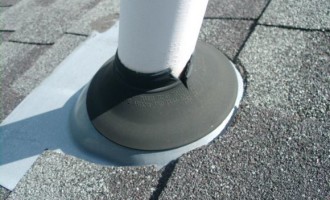How To Know If There's A Hole...

If you have a hole in your roof right now, how would you know? What if the water was soaking into your insulation and you couldn't see it yet? Could it be that it is rotting out the wood in your attic?
Take a look. Do you think this roof has damage?

There's only 1 way to find out. Get a complete roof inspection!
1. Knowing & Showing
Have your contractor do a detailed inspection including a video or at least pictures of what they find. This should include shingles, pipe boots, ventilation, gutters and drip edge.
Why do I need a thorough roof inspection? Just like the human body, your roof is a complete system. Missing drip edge means water can rot your fascia board, and rats can get into your attic. Yuck! The National Roofing Contractors Association recommends you get your roof inspected 2X a year. Even little things like leaves cause your roof to retain moisture causing algae growth and premature rotting.
Here’s the Roof pictured above. We had to get CLOSE to see the severe damage to the ridge.
2. Shingle What?
Find out what kind of shingles you have and what the expected life span is. Most people have a builders grade 3 tab whose life span is 15-25 years. Many have architectural or laminated shingles which are rated 30-50 years.
Some homeowners however have Atlas Chalet, which can be defective, cracking, and losing granules 25 years before it should! Each shingle requires a different approach to maintenance or replacement.

A) 3 Tab Shingles are extremely susceptible to wind and hail damage. Most roofs older than 10-15 years will be eligible for insurance to help pay for a roof replacement. The shingles are also very vulnerable to algae growth and therfore black staining. You can’t power wash it off unless you are using a gentle spray of part bleach and water.

B) Architectural Shingles are considered lifetime shingles. They are nearly twice as thick as 3 tabs and much longer lasting. They tend to last 30-50 years.
In order to damage architectural shingles you typically need winds in excess of 100 MPH, or at least quarter size hail.
Most issues with these shingles will be a result of birds pecking at the ridge caps, people walking on the roof, or poor installation. The image above shows where the shingles were high nailed and as a result have slid down the roof creating a huge potential for leaks.

C) ATLAS CHALET Shingles are a horse of a different color. They are considered defective due to cracking, blistering, and being extremely susceptible to wind damage. They also lose granules at an accelerated rate; literally the life of the shingles sheds off nearly 10X faster than designed. Because the Atlas chalet shingle is a faux architectural shingle it uses glued on granules to simulate a laminate/3D look at a reduced cost. Bottom line it pretends to be architectural but is not. Insurance will often pay to replace the entire roof as a result!
3 Tab With Wind & Hail Damage, Architectural Shingles with Hail Damage, & Cracking on Atlas Chalet Shingles.
3. These Boots Are Made For Venting
Pipe Boots are the single most vulnerable area of your roof. Because they are a direct protrusion they require a collar to prevent water from getting into the home. The collar is typically made of neoprene and wears down over 5-8 years. If the collar begins to crack it will leak. Using a perma boot is a far better solution. It comes with a lifetime warranty, and is made of an extremely durable plastic polymer.
4. Attic Check!

The life span of your roof is determined largely by the amount of insulation and ventilation you have. For example Ridge Vents provide the most effective edge to edge ventilation on a ridge roof & an insulated attic hatch prevents the 40% of heating and cooling normally lost! The better insulated your attic is, the less work it takes your heat pump and air conditioning to keep the temperature comfy in your home. The better ventilation on a roof the longer the shingles will last because it keeps the roof cooler.
5. Tar Paper VS. Synthetic Felt
Contrary to popular belief water does get under your shingles. More often than not the tar paper is there to try and stop it. The problem? Tar paper is water absorbent. A much better option is synthetic felt; a tarp-like material that grips better than tar paper, and it 100% water proof! Tar paper is black and ripples easily while Synthetic felt lays flatter, often creating a much smoother, better looking roof.











